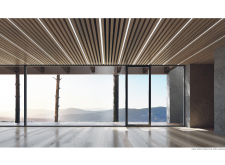5 key facts about this project
The design situates itself within a landscape that emphasizes sustainability and a strong bond with the surrounding natural features. The building serves multiple functions, aimed at promoting user interaction and environmental responsibility. The overall concept highlights the use of renewable energy and practical design, resulting in a space that is modern yet grounded.
Sustainable Energy Integration
Solar panels are a key feature, carefully placed to meet the building's energy needs. A utility room is essential for managing the energy collected from these panels, along with a rainwater collection system. This combination reflects a commitment to environmental responsibility, allowing the building to be more self-sufficient while using resources wisely.
Natural Light and Views
Panoramic windows have been incorporated throughout the design to take advantage of views of the valley and to bring in ample natural light. This choice creates a closer connection between interior spaces and the outside world, enriching the overall user experience. The presence of natural light not only enhances the space aesthetically but also reduces reliance on artificial lighting during daylight hours.
Structural and Elevation Characteristics
The structure features a light wooden lattice framework that presents a modern architectural approach. A pile foundation has been used to minimize excavation, preserving the site's natural landscape. The building's elevations are finished with light grey plaster, complemented by thin timber slats. This combination results in a façade that balances contemporary design with a sense of warmth and approachability.
Functional Layout and Design Details
The layout is thoughtfully organized into distinct functional areas, including waiting spaces and areas for communication. Practical elements such as changing rooms, showers, and toilets enhance accessibility and user comfort. An open area serves as a flexible space for various activities, supporting a dynamic use of the interior. The green roof functions as a garden, providing an opportunity for interaction with nature and completing the design narrative with an added layer of outdoor engagement.






















































